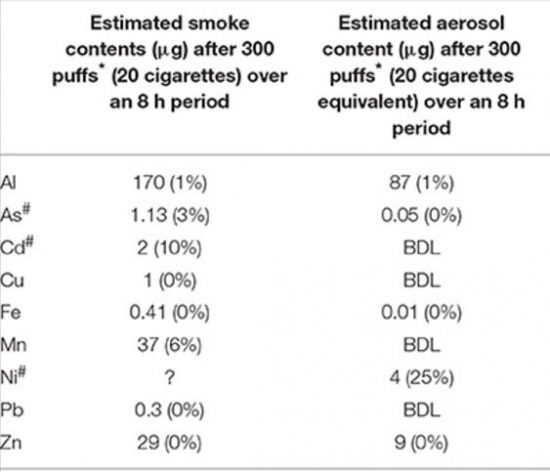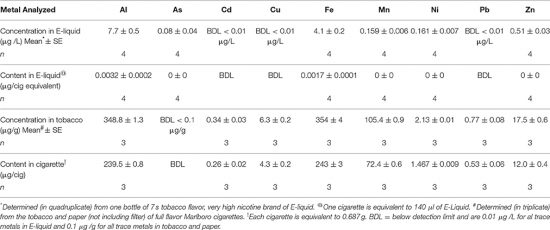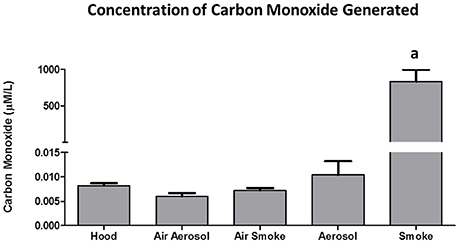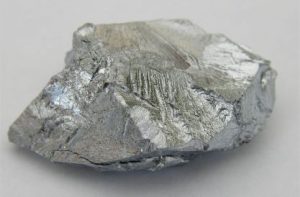Study on Trace Metals Compares E-Cigarette Aerosol and Tobacco Smoke
A comparative analysis of trace metals in e-cigarette aerosol and cigarette smoke reveals that, except for the element nickel (Ni), metal concentrations in e-cigarette vapor are at least one order of magnitude lower than those detected in the smoke produced by tobacco cigarettes.
 One of the main arguments used by vaping opponents is that e-cigarette aerosol contains dangerous levels of trace metals that become trapped in respiratory tissues and cause cancer. Previous research on this subject has indeed identified concentrations of various metals in e-cig vapor, although the general consensus so far is that these levels are considerably lower than those present in tobacco smoke. A new study published in the Frontiers Journal seems to confirm this theory.
One of the main arguments used by vaping opponents is that e-cigarette aerosol contains dangerous levels of trace metals that become trapped in respiratory tissues and cause cancer. Previous research on this subject has indeed identified concentrations of various metals in e-cig vapor, although the general consensus so far is that these levels are considerably lower than those present in tobacco smoke. A new study published in the Frontiers Journal seems to confirm this theory.
Conducted by a team of researchers from the Lincoln Memorial University, in Harrogate, Tennessee, and William Carey University, in Hattiesburg, Mississippi, the Trace metals derived from electronic cigarette (ECIG) generated aerosol: potential problem of ECIG devices that contain nickel study compares trace metal levels in the vapor generated by an eGo-style electronic cigarettes and a popular tobacco cigarette.
Scientists used peristaltic pumps to generate and transport aerosol and tobacco smoke onto mixed cellulose ester (MCE) membranes and analyzed the samples, comparing the levels of aluminum (Al), arsenic (As), cadmium (Cd), copper (Cu), iron (Fe), manganese (Mn), nickel (Ni), lead (Pb), and zinc (Zn). The presence of trace metals on unexposed MCE membranes was used as control.
One of the limitations acknowledged by the authors of this study was that a single model of e-cigarette and only one type of e-liquid were used to generate the aerosol – a Triple 3 eGo-style electronic cigarette with a CE4 clearomizer and 7’s tobacco-flavored e-liquid (80%PG/20%VG) with a high nicotine concentration. With hundreds, if not thousands of different e-cigarettes and mods currently available on the market, testing every possible combination is virtually impossible, but at the same time, researchers admit that their findings may well vary according to hardware, e-liquid and power output.
Despite these notable limitations, the study findings are still significant, as they reveal key information, like the most likely source of trace metals in e-cigarette aerosol, the fundamental difference between vapor and smoke, and the huge difference in metal concentrations when comparing vapor and smoke.
The most significant finding of this study was that with the exception of nickel, concentrations of trace metals in e-cigarette vapor were lower than those detected in cigarette smoke (they used a Marlboro 84mm, full strength cigarette), and comparable with the control samples.
Photo: study chart
“None of the analyzed trace metals on aerosol-exposed MCE membranes are significantly different from control membranes, except for Ni, which is nearly five times higher than the Ni content on control membranes,” the study states. “The contents of Al, As, Fe, Mn, and Zn on MCE membranes exposed to smoke are significantly higher than on control membranes. Similarly, the contents of Al, As, Cu, Fe, and Mn on MCE membranes exposed to smoke are significantly higher than those found on membranes exposed to aerosol.”
Similarly, the analysis of e-liquid before aerosolization and cigarette (tobacco and paper) before combustion revealed that with the exception of arsenic (As) the content of all trace metals, on a per cigarette basis, are at least an order of magnitude higher in the tobacco and paper of a cigarette as compared to the e-liquid. “Although, the content of As in the E-liquid is quite low, the As in the tobacco and paper is below the detection limit,” the authors note.
Photo: study chart
These two results are enough to suggest that the unusually high concentration of nickel (Ni) in e-cigarette aerosol is not caused by the e-liquid itself, but rather by the hardware, more specifically the heating element and other metallic components. This is confirmed by the analysis of these materials carried out during the study. Researchers found that the coil of the Triple 3 clearomizer used during testing was made primarily of nickel (76%), as were the weld joint connecting the coil to the thick extension wire (84% nickel) and the extension wire beyond the weld (89% nickel).
The authors write that the transfer of nickel from the solid phase to the e-liquid may depend on several factors among which the corrosiveness of the e-liquid, its pH and the presence of organic acceptors like proteins, for example.
There has been a lot of controversy around nickel (Ni) being used as a temperature control material, for years, and the results of this study suggest that there is indeed cause for concern. “With the advent of new generation temperature controlled (TC) ECIG devices, Ni toxicity becomes an even more critical issue,” the authors write. “The presence of Ni in many commercially available ECIG devices, coupled with its presence in ECIG-generated aerosol, could potentially lead to health related issues such as reactions induced by Ni allergies or even cancer. Consequently, the use of excessive Ni in the manufacturing of ECIG devices should be minimized.”
The authors incorrectly state that “the problem with TC devices is that they exclusively use coils made of 99% pure Ni. Pure Ni, also referred to as Ni200, is the best material available to construct coils for TC enabled devices. The reasoning is that the resistance of Ni200 coils is extremely low, but increases significantly as the coil heats. Consequently, temperature can be precisely calculated when using coils constructed of Ni200.” The truth is that we currently have two alternatives to nickel in temperature control mode – stainless steel and titanium.
I personally only use stainless steel coils in TC mode, and I have long advised vapers to stay away from Ni200 coils until we figure out the health implications of using this material. This latest study confirms that nickel is not the optimal choice of temperature control material.
The silver lining – if you can even call it that – with this whole nickel issue is that research has shown that the carcinogenicity of this material is related to its ability to form nickel carbonyl (Ni(CO)4) in the presence of carbon monoxide. This is where the fundamental difference between vapor and smoke comes into play. As this study shows, very little carbon monoxide is produced by vaping, compared to the massive amounts produced by smoking (0.010 ± 0.003 μM/L compared to 831 ± 166 μM/L).
Photo: study chart
However, the authors note that “the presence of Ni in ECIG-generated aerosol could present an increased risk of carcinogenicity, especially among dual-use individuals (i.e., those individuals who both use ECIGs and smoke),” because they expose themselves to high levels of both nickel and carbon dioxide. This is a big deal, considering that e-cigarettes are mostly used by smokers trying to quit.
“From the low levels of all other trace metals and their relationship to estimated maximum allowed inhalation, it is unlikely that the other trace metals detected in ECIG-generated aerosol pose any serious pathological risks,” the study concludes.
That’s also very important to note, because the high concentration of nickel (Ni) is simply a manufacturing problem. With several alternative materials already available, if manufacturers stop using high-nickel coils and tank components, we essentially eliminate the risk of exposure.
On one hand, this study emphasizes the difference between electronic cigarettes and tobacco cigarettes regarding trace metals, but also the need for regulators to focus on quality control, rather than on baseless concepts like the “gateway to smoking for youths” and the “danger of nicotine exposure.”



















